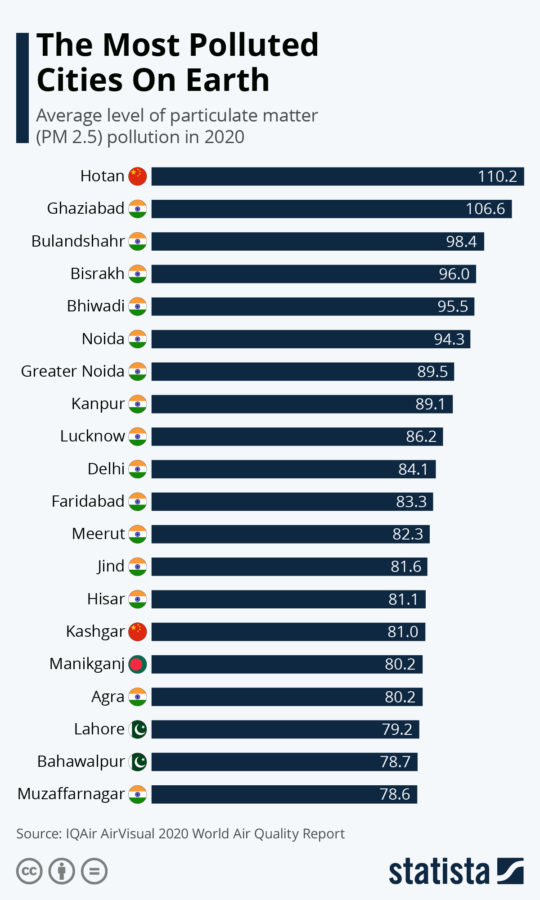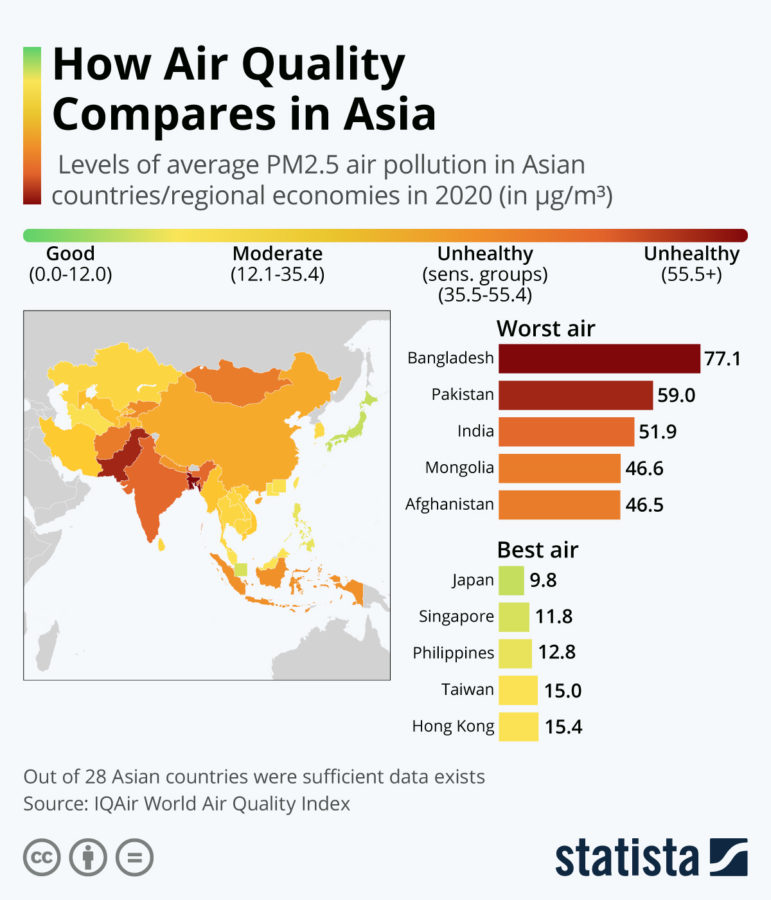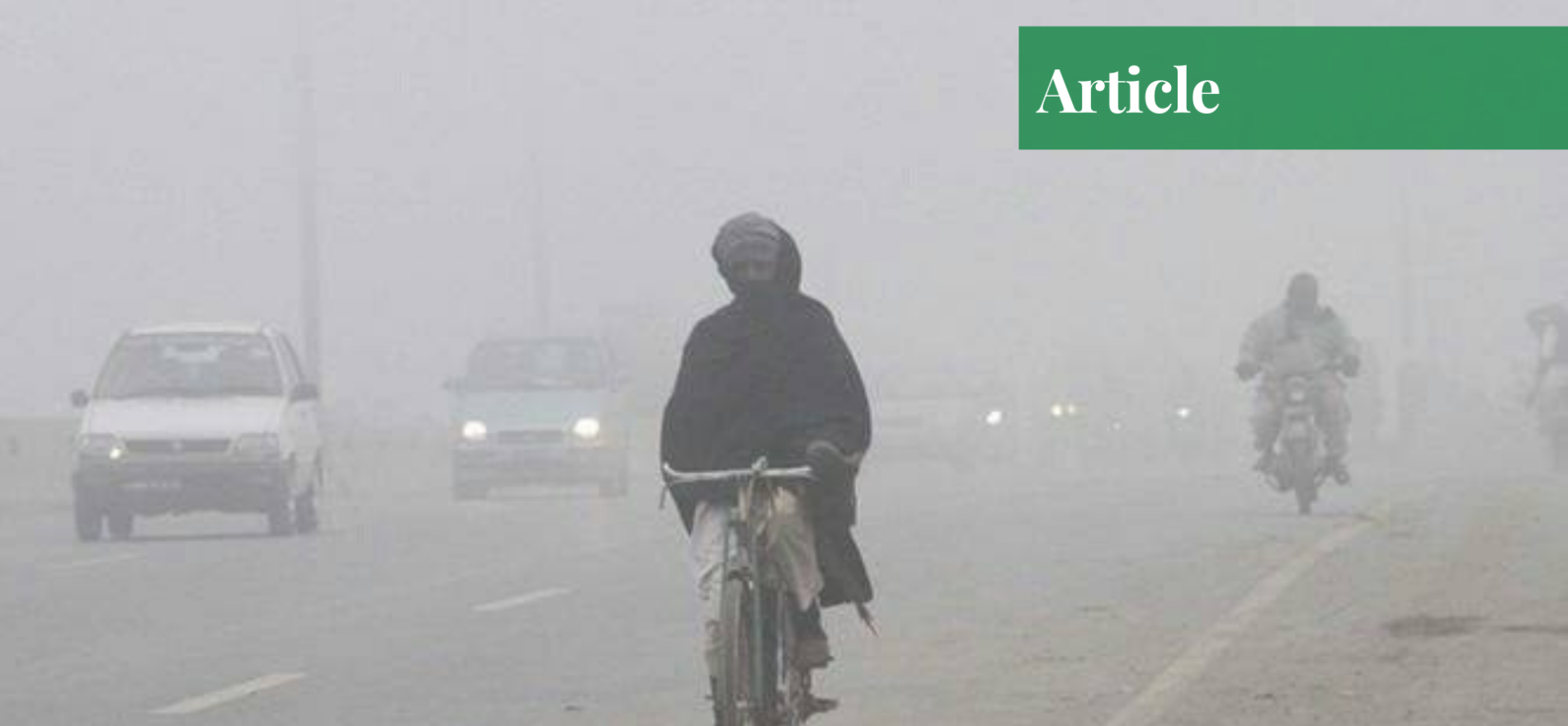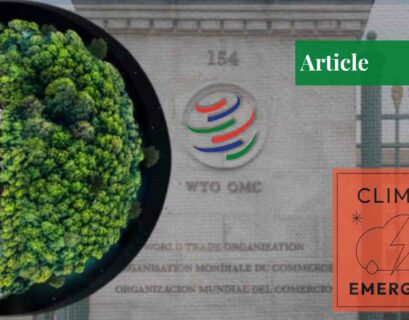Ms Ayesha Zafar is currently pursuing her Bachelor's in International Relations from National Defence University, Islamabad. She has authored multiple academic publications including research articles and book chapters. Her areas of interest include Middle Eastern politics, the geopolitics of Central Asia, and the Indo-Pacific region
Air Pollution in Lahore
Humanity has reached the moment of truth. On 11th November 2021, Lahore was declared the most polluted city of the world, descending gradually into dreaded smog. Lahore which once was known as the “City of Gardens” is struggling to ensure a clean healthy environment for its residents. The journey from being the City of Gardens to the most polluted city of the world is outrageous.
Today, Twitter is trending with the slogan “Lahore you’re killing me”. The air quality of Lahore has been declared “hazardous” which has generated alarm for the public and the officials alike. Yet, ironically, in Pakistan, it’s always too late to take action.
Since 2014, the increasing smog concentration in Lahore from the month of October till February, also known as “smog season”, has been a routine matter. Back in 2018, Lahore was ranked among the top 10 countries in the IQAir AirVisuals, and by November 2020, smog reached a hazardous level in Punjab with Lahore and Faisalabad topping the list of the world’s most polluted cities.

Nonetheless, throughout this year, Lahore’s air quality kept on worsening and has finally crossed New Delhi with the Air Quality Index (AQI) score exceeding 700. According to the index, a score of more than 100 is unhealthy while that of more than 301 is “hazardous”. At an AQI score of 397, the air pollution concentration in Lahore is calculated to be 34.8 times higher than World Health Organisation’s set annual air quality guidelines. Thus, making it the most polluted city in the world.
Unfortunately, Pakistan is also ranked the world’s second most polluted country with an average PM 2.5 (particles with a less than 2.5 micrometers diameter) concentration of 65.81. Therefore, it comes as no surprise that Lahore is the most polluted city in the world. However, nothing substantial has been done till now to mitigate the effect.

Is India to Blame for the Smog in Lahore?
A few days ago when the AQI score of Lahore reached 223, the Punjab government sprang into action and directed speedy arrangements to mitigate the climate change effect in the city. Yet, the authorities put the burden of responsibility on the Indian side of Punjab as Lahore District Officer Ali Ejaz stated, “The smog is coming from India due to the burning of crop residue”. However, according to the records, on Monday the AQI score of Amritsar in India was only 189, while that of Lahore was 289.
Hence, the statement doesn’t match the statistics and shows the negligence on part of the government to timely tackle the problem. Not just this, according to reports, the smog in Lahore is completely indigenous since wind is flowing towards India which means air pollution from across the border has not yet entered Pakistan. Thus, it’s more worrying to see what will happen when the wind will change its direction, and pollution from the Indian side will add to the problem.
Depreciation of the Smog Situation in Lahore
More importantly, the city of Lahore has always been among the most polluted cities of the world, yet the public consciousness about the issue rose back in 2017 when the actionable air quality data came out in front of the public for the first time. At that time, a massive petition by the citizens criticizing the government’s poor management of the smog in Lahore was recorded. Henceforth, the Lahore High Court took action and directed the concerned authorities to update the smog response action plan.
Nevertheless, Punjab Environment Protection Council was criticized for underreporting the severity of air pollution in Lahore. The AQI reports say that a PM 2.5 concentration of 60 micrograms per cubic meter in the air is “unhealthy”, yet authorities in Punjab declared such concentration as “satisfactory” saying that it may cause minor breathing discomfort to sensitive people.
Today, the situation is more alarming. Pulmonologists have advised people to wear a mask while going out. An official from the environmental department has claimed that “what makes the matter dangerous is that it’s not smog rather it’s pure pollution”. Pakistan’s meteorological department forecasted dry weather for the next 48 hours which means no rain in the coming days to provide any relief against the increasing smog.
Other than that, one in every two days in this month is categorized as “hazardous” by the air quality monitors installed by the US consulates in Lahore. The data by Pakistan Air Quality Initiative shows that Lahore will not be having a single day of healthy air this year. Not just this, the wind speed that could carry away the pollutants in the air was recorded only at five knots. Thus, reducing any chance of pollutants being carried away through the wind in the days to come.
This would ultimately lead to harmful impacts on people already suffering from asthma since polluted air with hazardous pollutants is going to make breathing difficult. Alongside, blurred vision due to dust particles in the air has not only caused respiratory issues, irritation in the eyes but has also increased the likelihood of road accidents. Henceforth, more than 13 million population in Lahore is at risk due to increasing air pollution, according to Amnesty International.
Initiatives to Counter Air Pollution in Lahore
All of this has raised questions on the performance of the government, key authorities, and the Environmental Protection Agency (EPA), which have failed to come up with a timely response mechanism and did nothing to mitigate the smog crisis in the city of Lahore. The dilemma is that EPA today has only one of its mobile vans working to monitor the level of PM2.5, while its eight other stations in the metropolis are either non-functional or not in a position to detect the increasing PM2.5 concentration.
Although the Punjab Disaster Management Authority (PDMA) has been directed to stop unregulated crop residue burning in Lahore, the practices have continued. Moreover, nothing has been done to keep a check on the brick kilns that are still operational and have not converted to zigzag technology.
Therefore, unless proper policy would be formulated keeping in view the increasing pollution, declining air quality, nothing substantial could be achieved. Merely paperwork is not enough, it requires strict action by the authorities to mitigate the issue. Unless and until industrial emissions, smoke from brick kilns, burning of crops residue, and construction sites are not monitored and regulated, pollution will keep on increasing.
The need is to have real-time air quality data available to the public so that they can realize the severity of the issue and can take steps at their level to mitigate the harmful impacts. Although the Environmental Protection Agency (EPA) has claimed to take action against industries causing pollution by closing down 60% of the 300 steel furnaces, yet the smog concentration is still exceeding the limits.
Punjab Green Development Program (PGDP) has plans to establish 10 air quality monitoring stations in Lahore, yet it is important to ensure that such actions are taken well in time. This is largely because it is every citizen’s “right to breathe clean air” which is guaranteed to them by the law. Accordingly, it is the responsibility of the government to undertake actions to ensure the provision and guarantee of such rights.
Unless steps would be taken to mitigate the smoke coming out from the industries burning tires that are contributing 25% to pollution, nothing could be achieved. Amnesty International has already urged Pakistan to take “urgent action” to mitigate the increasing concentration of smog in Lahore. Henceforth, a timely and efficacious response is a need of the hour.
Hereby, keeping in view the deteriorating situation, the Punjab government has decided to mull artificial rain in the city and has claimed to collect Rs. 102.697 million in penalties. The transport department alone has imposed penalties worth Rs. 27.14 million on vehicles producing pollution in Lahore, and around 20,273 industrial units and 2,434 brick kilns have been fined. Likewise, the district administration on Saturday constituted five “anti-smog squads” to monitor the level of pollution in the city.
The Lahore High Court has recently ordered the Punjab government to ensure the implementation of recommendations set forth by the smog commission of 2017. This includes cutting emissions from factories, planting trees in urban areas, shutting down the brick kilns that have not converted to advanced zigzag technology, and imposition of fines on polluters.
Apart from all, Prime Minister Imran Khan on Saturday, after meeting with Chief Minister Usman Buzdar, has announced to take concrete actions to curb the issue of air pollution in Lahore. The measures would include importing only that oil which will meet EU Euro-4 emission standard, and making the auto-industries shift towards electric vehicles.
Likewise, measures would be taken to import machinery that could help farmers reuse the post-harvest rice crops rather than burning them, and all brick kilns will be given financial aid to adjust to new zigzag technology. More importantly, an initiative was undertaken to plant trees in an area of 60,000 kanals in Lahore.
PDMA has also undertaken steps to impose a fine worth Rs. 50,000 to Rs. 100,000 on the brick kilns that are violating the regulations, and a fine of Rs. 50,000 on individuals caught burning stubbles. Not just this, the Punjab Local Government Act 2019 also directs the city municipal authorities to ensure water sprinkling on roads, streets, and construction sites producing dust. Section 144 has been imposed to control smog by taking action against those causing environmental pollution. Under this, the burning of crops residue is banned from October 6th, 2021.
Conclusion
Nevertheless, all these measures require an effective and timely response by the government for implementation. Had these measures been taken earlier and with full responsibility, Lahore wouldn’t have been the most polluted city in the world. Hence, pollution is a silent killer and there is a need to realize the severity of the issue. It is time to head towards an early response mechanism rather than to wait for problems to deteriorate when the solution often seems ineffective. It’s our country, and only through collective efforts and actions can we mitigate the environmental pollution and can guarantee a safe and healthy environment for our generations to come.
If you want to submit your articles and/or research papers, please check the Submissions page.
The views and opinions expressed in this article/paper are the author’s own and do not necessarily reflect the editorial position of Paradigm Shift.



















